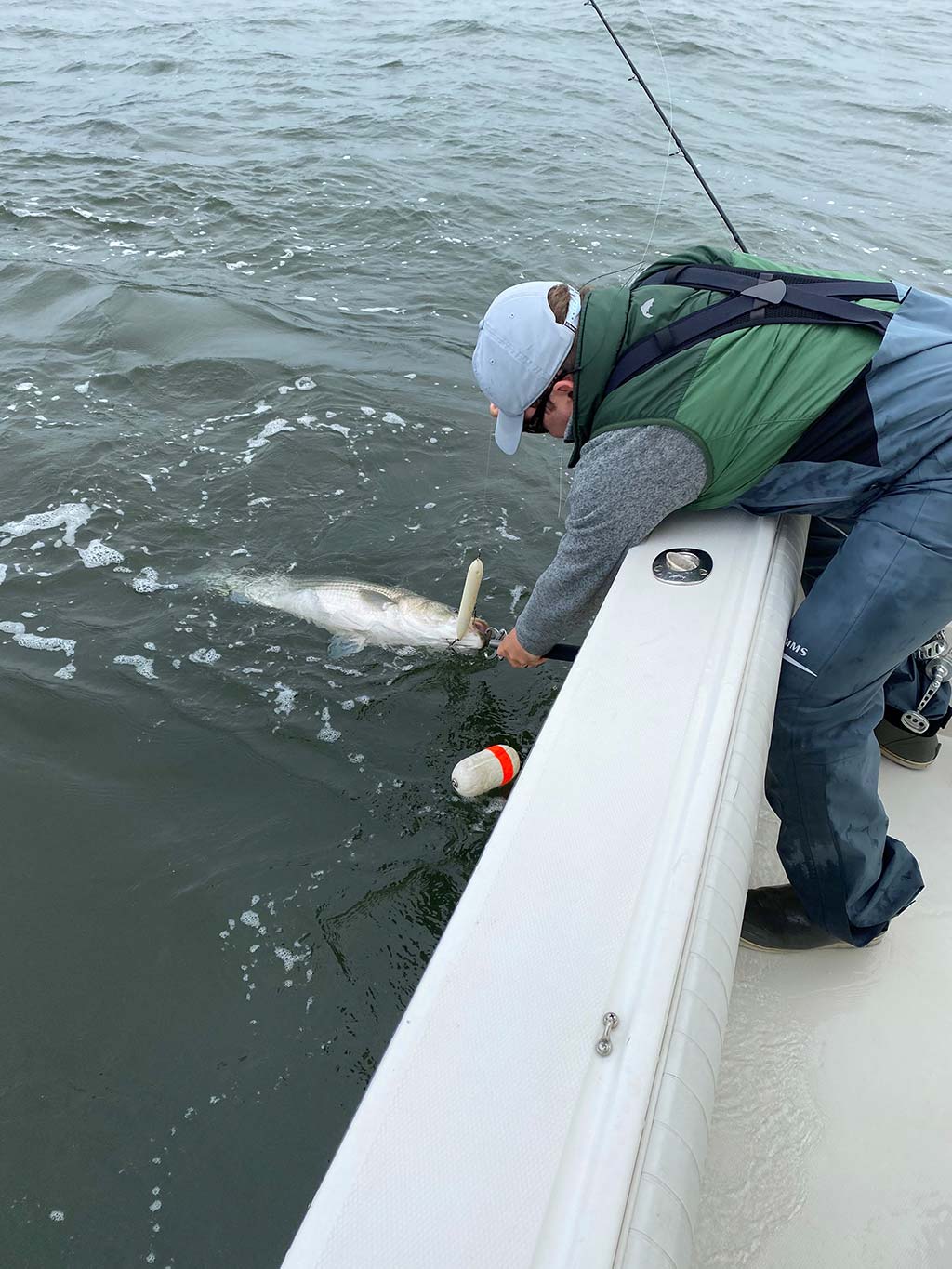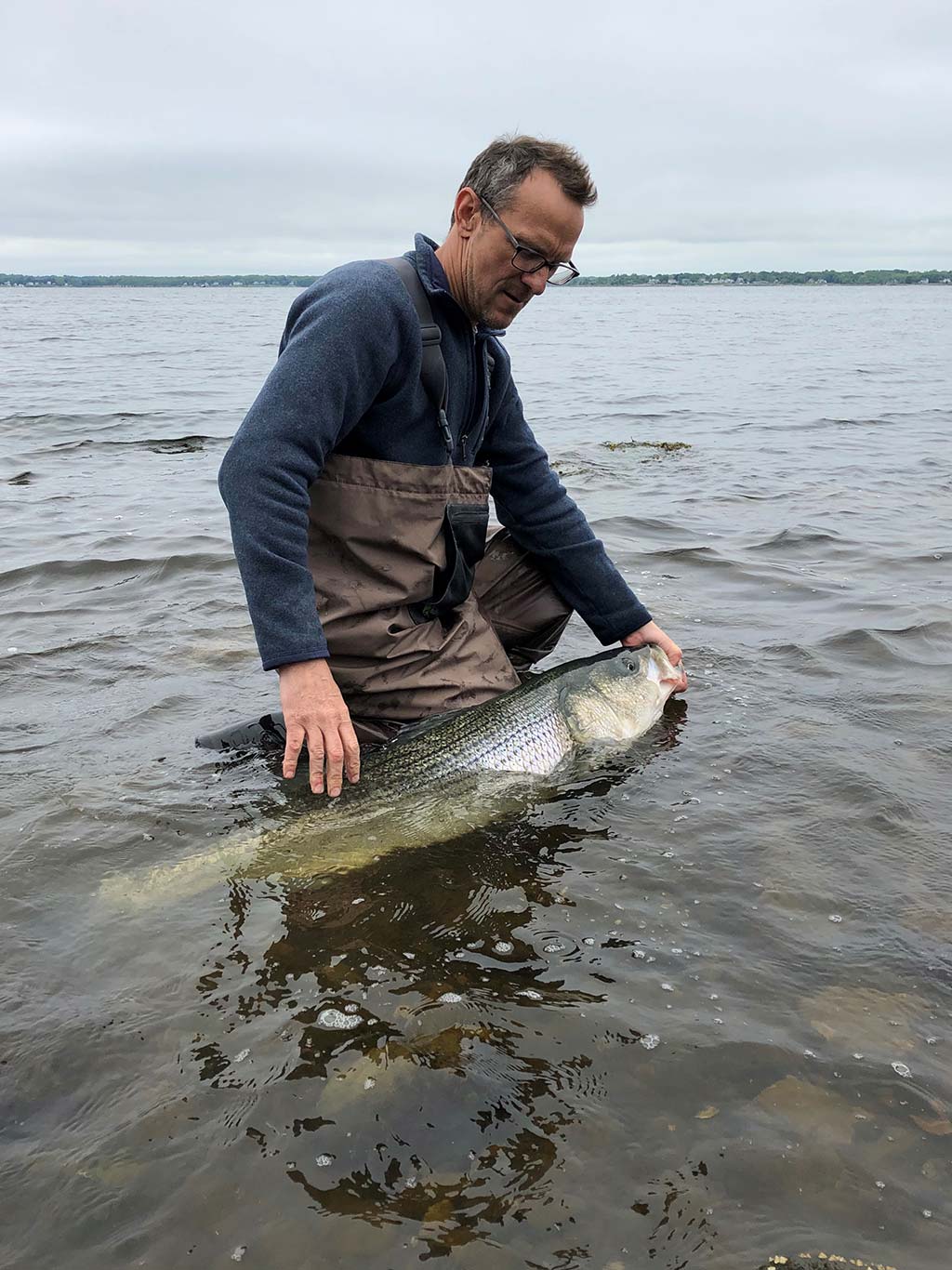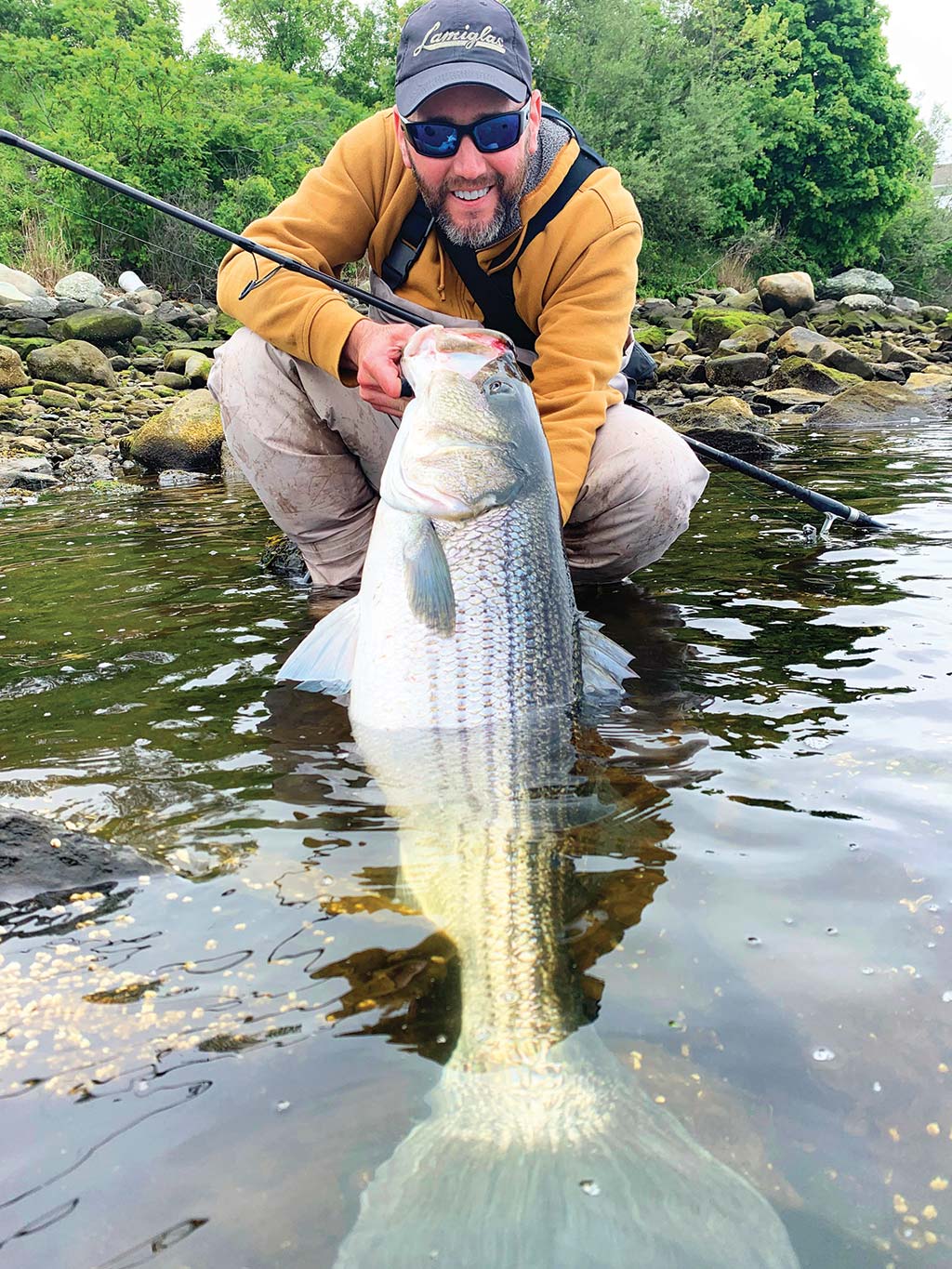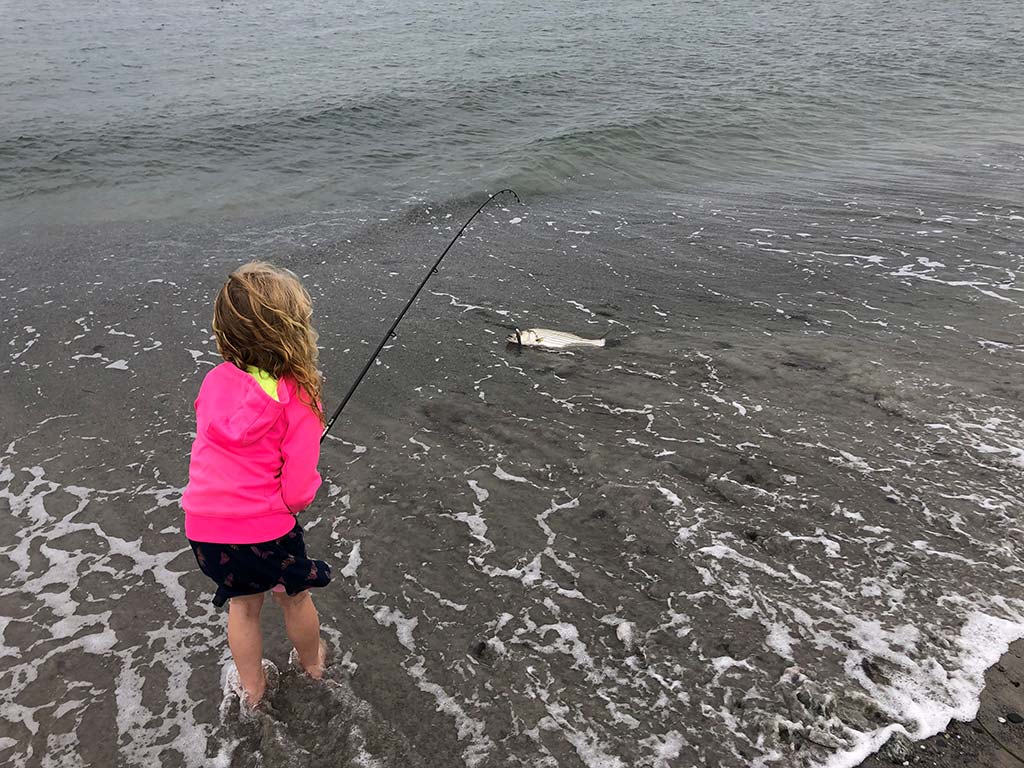
The versatility of the spook is what makes it the perfect choice.
Let’s meditate for a minute; even breaths in through your nose, out through your mouth, let your shoulders relax, let your jaw relax, let your hands relax… Now picture a cool morning in June—let’s make it this Saturday morning. The sun has not yet revealed its fiery self, just the glow. The water is a perfect undulating mirror of the heavens. Nevertheless, you know better than to drink in all this imagery; wipe that wistful gaze off your face, pocket those tissues! Underneath all this breathy perfection is a shadowy boulder-strewn flat at the edge of a sharp drop-off, bunker flips are present as far as the eye can see and, when the tide comes up to speed, this serene seascape will transform into a killing field. Large bass are staging in the deep and will move into shallower positions as the quickening tide delivers on its daily promise of bunker.
So why do I put so much emphasis on a level resting angle? If you’ve read this story from the top then you know that I put a lot of stock into pausing the plug, I do this because it’s the best way I know of to sell my plug as stunned or exhausted. But if your plug drops its tail and floats like a message in a bottle, that fish that’s pursuing your spook is going to see that something is not right about your plug and lose interest. Trust me, I’ve tested this.
Now let me tell you how I see it. As the tide begins pull across the flat, I’m not going to be reaching for a snag hook, I want a plug to do the dirty work, and that plug is going to be a large walk-the-dog style lure. I could use a Pencil Popper, they create more commotion and cover more water, but most pencils drop into an unnatural position when paused. I could use a large Pikie or Danny, but metal lips are a one-note offering, they really only work at slow speeds and don’t offer the opportunity to react to an interested striper rolling behind the plug. The versatility of the spook is what makes it the perfect choice.
The Perfect Spook
I’ve been at this long enough to remember when the spook-style plug became ‘a thing’ in striper fishing. No, I don’t mean way back in the 1950s when someone tied a Ballerina on and threw it to stripers, I mean in the early 2000s when the effectiveness of the Jumpin’ Minnow started to leak out and hobbyist plug builders began cranking out their own creations. What I gained from all that tinkering was an understanding that there are two types of spooks, those that zig-zag tightly and then those magic ones that glide effortlessly, 2 or more feet in either direction, these are the ones that get the attention of these big bunker fish.
So how can you tell if you have a good one? It’s all about the resting angle. Take that spook, toss it in the water and if it floats with its head slightly higher than the tail, you’re in business. The size of the plug has a lot to do with its gliding action too, the bigger the better. Smaller spooks catch plenty of fish (more on that in a minute) but you’ll never get that massive glide with anything shorter than 8 inches.
When working a large spook there are two ways to achieve the same result. If you’re fishing from a boat, you can simply swing the rod across your body to your ‘reel hand side’ and time quick cranks of the reel with sharp-whippy-sideways-pops of the tip. If you’re a surf guy chucking plugs on a 9-foot or larger rod, I don’t recommend fishing the rod out to the side, tennis elbow is no fun, trust me. I keep the rod butt between my legs and use sharp, upward pops of the tip to walk the dog, the only time I drop the tip is if a fish is chasing the plug when it’s close to me.
The two big keys to getting the widest walk, are sharp, short pops while allowing enough slack to fall between each pop that the plug can glide without being affected by the drag of the line. Keeping all this working in a rhythm can be a challenge, especially when fishing from a drifting boat because you also have account for the drift. If you’re drifting toward the plug then you will have to make your tip pops much harder and more deliberate—while keeping the line tight—and then stopping for a half-breath to glide, then winding double-time to catch back up to the plug before popping it again. If you’re drifting away from the plug, it may take some Matrix-esque maneuvering to be consistent in your cadence. Maybe I should have saved the meditating part until the end.

Small Spooks
There is an abundance of small spooks on tackle shop walls and, like their larger, ‘glidier’, cousins, they are not all the same. You’re not going to find any with that same ‘jerk-gliiiiide-jerk’ action that you can get from an 8- or 9-inch spook—it seems to be physically impossible to replicate that, even on a smaller scale. What you’re going to look for instead is a level-float plug that turns violently left and right when you jerk the rod tip. If you’ve ever watched an injured or confused baitfish freaking out on the surface, then you can understand why the action I’m describing is a good thing. The main think I look for in a smaller spook is responsiveness; some builders try to make them cast better by making them heavy in the rear, but this makes them sluggish and hard to work. And, if a long cast is needed, I’m going to grab a Pencil Popper anyway, when I know a spook is the right choice, I’m not worrying about distance.
So, if I’m doing my job here, you should understand that a longer, larger spook should glide and a shorter spook should be splashy and responsive. I tend to work these smaller plugs hard enough that I can hear them sloshing the whole way in. Something I have learned along the way is that smaller spooks really benefit from having an ovate or even rectangular cross-section, meaning they are taller than they are wide. This is especially true when you’re choosing a spook of 6 inches or less. The flatter sides create small, turbulent eddies that push the plug harder left or right, the flattened sides also contribute to increased sound, because they push more water. There are exceptions, like the Heddon Super Spook, these small, ‘cylindrical’ plugs still feature accentuated action because the line tie is below center, which helps the plug scatter left and right by augmenting the pivot point and using it to fight against the buoyancy of the plug. Still, I tend to lean toward these taller profiles most of the time because I like their action and sound better.

The Thought Process
So why are spooks my favorite topwater plug? For starters, they have amazing drawing power and will sometimes pull fish off structure in as much as 20-feet of water! And, let me tell you, when a big fish comes up 20 feet to crush your plug, the hit is not something you’ll soon forget! But beyond that, the thing I love so much about them is that they can be fished in a variety of moods and at an infinite number of speeds. When I talk about moods, I mean that I can convey different attitudes to the fish—I can work it slow and broken or fast and freaked out or any increment in between. I typically start out with a steady cadence, about one ‘pop’ every 1 to 2 seconds. This is when I’m in search mode and trying to get a fish to show itself. If I draw attention but can’t close the deal, I will remove the pattern from my next few retrieves—I’ll break the retrieve up into bursts of faster pops, adding in the occasional pause of 2 to 4 seconds, then I might slow it way down with intermittent pops and rest periods. To me, this looks the most natural, it’s how a wounded bunker acts, I’ve seen it dozens of times. But the place where a lot of people fall short is when a fish boils on the plug.
I take a boil as a challenge. I think of it as the fish telling me that she’s interested, but not convinced—it’s as if she’s testing the plug to see if it will react. This is when I powershift and make the bait react as if it’s realized that something is trying to eat it, I work the plug as if it were trying escape. I start by swimming the bait faster in a shorter, steadier walking cadence, if the fish boils or slaps the plug again, I go faster and faster until it’s just short of frantic. Sometimes the fish will assault the plug five or more times! If they make solid contact, but miss the hooks, I’ll stop the plug and allow it lie motionless on the surface for several seconds before working it very slowly, as if it were stunned and starting to come back to life. This usually results in a fast and explosive take. Fun, doesn’t even begin to describe it.

My Top Five
1 – It might not be a huge surprise that my all-time favorite spook-style lure is the 9-inch Big Doc made by Drifter Tackle. Theis plug has taken the striper world by storm over the past four years, but I have been fishing them for 15 years, sworn to secrecy by the small group of guys that discovered them. This plug has accounted for big numbers of 20- to 40-pound fish for myself and the guys I fish with and countless fish over 40, 50 and at least two 60s that I know of. It’s perfectly-balanced and the low frequency rattles drive big fish crazy.
2 – The next one on my list is the ‘Lil’ Doc, the 7-inch version of the Big Doc. This plug features the widest walk you’re going to find on a 7-inch spook. I typically only use this bait in the springtime when there aren’t many fish over 20 pounds around, but fish of any size will eat this thing when the profile matches the size of the forage.
3 – Now we drop down into an ‘honorable mention’, the Tattoo Sea Dog was an awesome plug that caught lots of fish in its heyday. I liked this 6.5-inch wooden lure because it was made in Rhode Island by a guy trying to make ends meet as a lure builder. But the reason I liked them above all other reasons is because they worked. I don’t even have any left, I wish I did, but this plug caught a lot of fish me over the years and I’m certain it would still crush today.
4 – The Yo-Zuri Hydro Pencil has been a staple in my spring and fall bag since my fishing partner showed me how effective these little 5-inch spooks are some 15 years ago. This is the ultimate example of the ovate cross-section spook that has a short and splashy walk. These baits are just awesome for bass of all sizes, but they also crush albies when they’re on larger baits like halfbeaks or mullet.
5 – And last, but not least, the OG. The Jumpin’ Minnow is often ignored by anglers that think of themselves as serious because they look too simple, almost like a toy. Ignoring the Jumpin’ Minnow is a mistake! These 4.5-inch baby spooks are amazing, swap out the stock hooks for size 1 or 1/0 VMC trebles and you’ll be blown away by their magnetic qualities with striped bass up to 20 pounds and don’t be surprised if you hook a giant either, these little plugs are the real deal.
I am tempted to use a cliché here and say something like “you can use any color as long as it’s white (or bone).” And I do think you’d be fine with just bone or pearl white. However, I do like to use chrome colors on cloudy days, I have found that chrome plugs can be too shiny in blazing sunlight. Another color I will sometimes reach for is chartreuse, I don’t have any rules of thumb for this, but sometimes they will eat chartreuse when nothing else is drawing interest.
By now it should be pretty-well obvious that I have an—almost—unhealthy affection for these amazing and exciting little stickbaits. As a plug fisherman, versatility translates directly to your ability to make the best possible presentation and if you haven’t hitched up to the spook train, let this moment be the one that gets you there. From 4 inches to 9 inches they all have their place and they all crush fish. It won’t be long before you’re dreaming about walking the dog too, just like I do.



